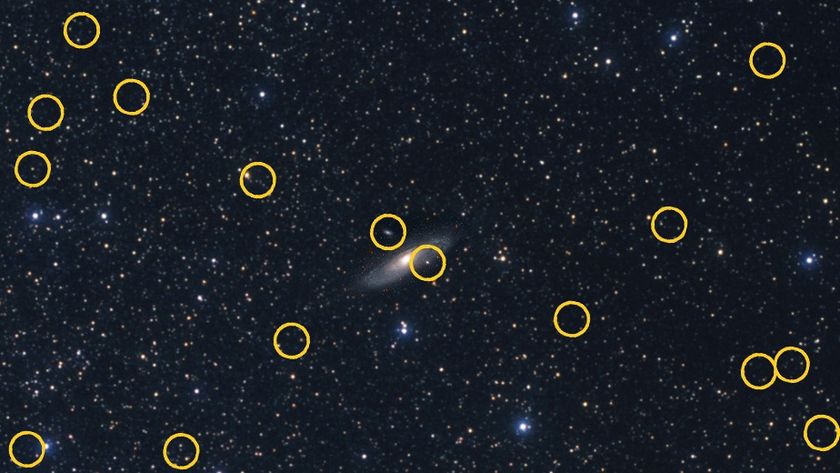Amateur astronomer finds 5 fascinating new galaxies — and they're now named after him
"To my knowledge, I am the first and only amateur astronomer to have galaxies named after them."
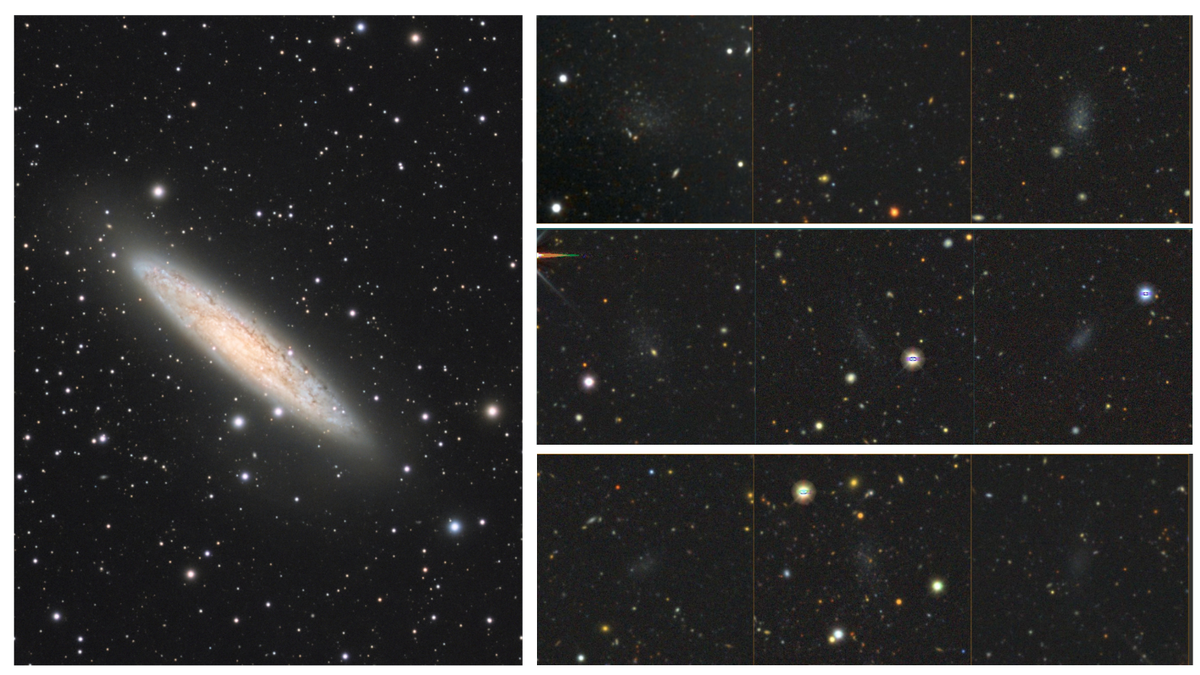
An amateur astronomer from Italy has discovered five new dwarf galaxies around a distant spiral galaxy — a spiral that's one of the largest galaxies in the sky over Earth. His name is Giuseppe Donatiello, and those five dwarf galaxies are now named Donatiello V, Donatiello VI, Donatiello VII, Donatiello VIII, and Donatiello IX (Do V, Do VI, Do VII, Do VIII, and Do IX).
"Out of eleven discoveries, nine galaxies bear my name. To my knowledge, I am the first and only amateur astronomer to have galaxies named after them," Donatiello told Space.com. "It all started with the first discovery in 2016 when, in my astrophotographs, I found what we would call Donatiello I. Although this was an unusual practice, the new galaxy received my name, and it was a great joy."
The newly discovered satellite galaxies join the previous three dwarf galaxies Donatiello discovered around the Sculptor galaxy, officially known as NGC 253 — and, in many ways, they are interesting for reasons other than their nomenclature.
Not only are ultrafaint small galaxies like these, which are an average of 11.5 million light-years away from Earth, difficult to detect, but these galaxies could help astronomers study the oldest stars in our universe, dissect the nature and distribution of dark matter, and perhaps even impact current models of cosmology.
Related: World's largest visible light telescope spies a galaxy cluster warping spacetime
"In general, dwarf galaxies are objects that exhibit very low luminosity. Suffice it to say that many satellites of the Milky Way are difficult to detect because they are well-camouflaged in the star fields," Donatiello said. "This becomes increasingly difficult for external galaxies. Already, at just a few megaparsecs [one megaparsec is equal to around 3.3 million light-years], the faintest dwarf galaxies have disappeared into the background of the sky.
"Each new discovery is therefore important both on the census front and for a better knowledge of these systems and their evolution."
Get the Space.com Newsletter
Breaking space news, the latest updates on rocket launches, skywatching events and more!
Where are all the dwarf galaxies?
As Donatiello explains, the Milky Way has its own satellite dwarf galaxies. By 1999, however, astronomers only knew of about a dozen dwarf galaxies around our galaxy — yet thanks to discoveries made from 2004 onwards, we are currently aware of around 60 satellite galaxies around our realm. This is interesting because it may tell us something about dark matter dynamics.
"We know that major galaxies must be nestled in the center of dark matter halos, extending well beyond the size of the stellar disk," Donatiello said. "According to cosmologists, these halos were formed first, acting as a gravitational well for the neutral gas at the origin of the very first stars, creating the first galaxies.
"Some of these halos have become dominant due to gravity, acting as an attractor for other nearby halos. This process activated the hierarchical formation of major galaxies. Furthermore, each halo contains a number of mini-halos which, in turn, formed the cosmic scaffolding for satellite galaxies."
There is a bit of a conundrum when it comes to satellite galaxies, however. It has to do with a highly favored model of cosmology known as the Lamba cold dark matter (LCDM) model, which suggests there should really be thousands of satellite galaxies around the Milky Way and other large galaxies. In fact, simulations made using LCDM predict that our neighboring galaxy, Andromeda, should be surrounded by 500 to 1,000 satellite galaxies. Yet, astronomers have seen just 39 around Andromeda — including Pisces VII and Pegasus V, which were discovered by Donatiello himself.
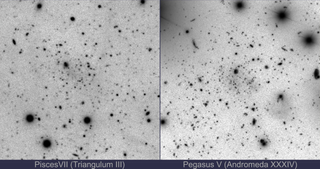
"This discrepancy has become known as the 'missing satellite problem.' After 25 years, no convincing solution has emerged because, even with the discovery of ultrafaint galaxies, the number remains markedly low," Donatiello explained. "There are still significantly fewer numbers of dwarf galaxies than expected, so the problem persists: Where are they all?"
This dilemma has led scientists to question whether the LCDM model can indeed predict that dark matter acts as a scaffold for the formation of the largest structures in the universe, but collapses when investigating the cosmos at smaller scales. Why would it fail to detect sufficient numbers of dwarf galaxies around large galaxies?
As to why all this matters, the study of dwarf galaxies is vital to our understanding of galactic evolution as it could also help us better understand the grisly cannibalistic processes larger galaxies like the Milky Way and Andromeda have used to grow.
"One of the satellites of NGC 253, Scl-MM-dw2, has already been seen to be undergoing tidal destruction in the process of being absorbed by the Sculptor galaxy," Donatiello said, explaining that the galaxy shows clear signs of recent interaction as well as hints of stellar streams, which refer to stars dragged out of a dwarf galaxy by gravitational interactions with a larger galaxy.
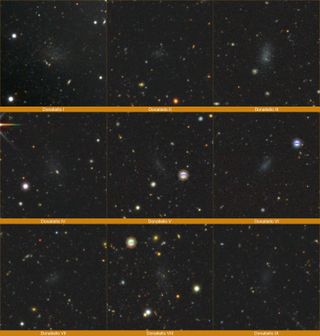
To investigate whether LCDM models may need revision or if efforts need to be upped to hunt dwarf galaxies around larger galaxies, Donatiello and team turned to archival data collected by the Dark Energy Spectroscopic Instrument (DESI) located on the 4-meter Mayall telescope at Kitt Peak National Observatory.
In 2021, the instrument began a five-year-long survey of 35 million galaxies and quasars, but Donatiello and colleagues specifically focused on its observations of the Sculptor galaxy and its vicinity. "NGC 253, thanks to its proximity, is an optimal laboratory for investigating these structures, their interaction and evolution," Donatiello said. "We can study the halo of this nearby galaxy by having an overall picture of it, which cannot happen for the Milky Way."
This study led to the discovery of eight dwarf galaxies in the Sculptor galactic group: the team revealed three of them in 2021, and the other five more recently. Astronomers now know of 18 galaxies in this grouping around NGC 253, including NGC 247, discovered in 2011, and some dwarf galaxies of greater mass.
Still, the team's new discoveries stand out because of their faintness.
"All the other satellite galaxies in this group are spheroidal dwarfs similar to the 'classical' satellite galaxies of the Milky Way, in the high-brightness area," Donatiello said. "Thanks to the census of the satellite galaxies of NGC 253, we now have a way to compare how fainter systems progressively disappear as the distance increases."
Lopsided and disorganized
The team's census of the Sculptor galaxy and its surroundings may have revealed more dwarf satellite galaxies, thus bringing the picture of this region closer to that predicted by LCDM, but it delivered a few surprises, too. This includes the fact that the distribution of dwarf galaxies around NGC 253 appears to be "lopsided," with more galaxies lying to one side of the Sculptor galaxy than the other.
Donatiello noted that the reason for this lopsidedness could be connected to the fact that Sculptor Group satellite galaxies are part of a galactic "filament" almost perfectly aligned with the Virgo Cluster, a large cluster of galaxies whose center is located around 54 million light-years away.
"What we consider satellite galaxies are actually falling objects attracted by the larger galaxy," he explained. "In all cases of structures in the same plane or with unbalanced distributions, we find a close relationship with this cosmic filament. So, we can hypothesize that the particular lopsided structure is driven by this scenario. Otherwise, we should expect a more even distribution."
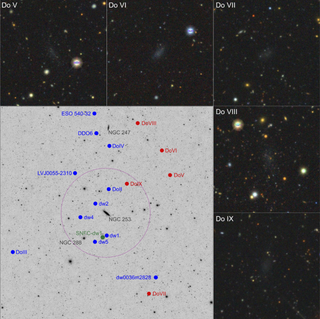
"Even more extreme objects have recently been found, made up of a few dozen stars, which we struggle to define as galaxies but more properly as halo clusters," Donatiello said. "There are likely hundreds of such star systems waiting to be discovered. There is still room for more discoveries. However, the DESI data may not be deep enough to find new low-luminosity candidates."
The amateur astronomer added that new, more powerful survey instruments such as the Vera C. Rubin Telescope could pick up this investigation by detecting systems dim enough that, at a certain distance, they become effectively invisible to current technology.
"What if we don't find enough ultrafaint dwarf galaxies to weaken the missing satellite problem?" Donatiello asked rhetorically. "We should take into consideration that the models need to be revised or that some mechanism takes over that inhibits star formation below a certain mass limit of dark matter halos.
"It may also be that there is something wrong with the timing of the formation of the larger galaxies, and most of the dwarf galaxies have almost all been swallowed up by the larger ones."
At this point, 9 galaxies, including the 8 dwarf satellites of the Sculptor galaxy, bear Donatiello's name — but for him, this investigation is more about the thrill of new discoveries than the honor of his name being integrated into astronomy textbooks.
"How does it feel having galaxies named after me?" he concluded. "It's a nice feeling, but I've gotten used to it a bit, too!"
The team's findings are available as a pre-peer-reviewed paper on the research repository arXiv.
Join our Space Forums to keep talking space on the latest missions, night sky and more! And if you have a news tip, correction or comment, let us know at: community@space.com.

Robert Lea is a science journalist in the U.K. whose articles have been published in Physics World, New Scientist, Astronomy Magazine, All About Space, Newsweek and ZME Science. He also writes about science communication for Elsevier and the European Journal of Physics. Rob holds a bachelor of science degree in physics and astronomy from the U.K.’s Open University. Follow him on Twitter @sciencef1rst.
-
mach0017 It's very fitting that Italians are continuing to be an important factor in galactic discoveries. Kudos to Donatiello for being so honored.Reply

